Standing Rib-Roast aka Prime Rib (Sous-Vide & Delta-T)
 For the last few years, I've been deconstructing the standing rib roast and gluing it back together using Transglutaminase, which makes for a better roast, more convenient to process, and the presentation looks better too.
For the last few years, I've been deconstructing the standing rib roast and gluing it back together using Transglutaminase, which makes for a better roast, more convenient to process, and the presentation looks better too. I will attempt to keep this short, but I doubt I will be able to do that! Here is an illustration of what I am trying to write about and hopefully clarify some thinking flaws regarding Sous-Vide Proteins' processing time. People often suggest Times that will not allow the protein to equalize (protein and water bath are at the same temperature). The people who make these suggestions and those who use them are unaware of proper cooking times for several reasons. Many have admitted they have not read Douglas Baldwin's book on Sous-Vide, which IMO is the first place I send people to brand new to SV. And secondly, most will say that they used their eyes to determine when a protein had been cooked properly, but obviously only after the fact. Visually one cannot tell the difference within a few degrees. I dedicated an entire article to this very subject called "Time to Temp? Can you tell which one is which?" For example, a protein cooked at 133f for XYZ time never equalized but reached 130f. The person would never know this unless they cooked with probes. Here is another example that makes me quiver with frustration- A person complains in a group that they processed a protein at 131f for 90-Minutes, and it came out underdone and very, very pink and tough. What does everyone suggest? They suggest increasing the temperature, thinking that this was the issue and not the Time. They don't know that the protein is about 2.5 inches thick and never got above 125-126f.
fan of pretreating all my proteins known as a Dry-Brine. I love using Fish-Salt because it amps up the Beef-Flavor. If you like, you can read about it HERE. If you are curious about the protein matrix and how we can penetrate it to give extra flavor, Click-HERE. Anyhow, I used .90% Fish-Salt and applied it thoroughly all over the Roast. I would normally use 1%, but I took into account the bones. The roast weighed in at 5411 grams x 0.9% = 48.70 grams. I used 50 grams of Fish-Salt.
I am always concerned about bag breakage, so I added some bone guard wraps. I placed them on the bones and used a few butcher strings to secure them. Re-Sealed.
The Roast was put in a vessel that measured 26 x 18 x 9 (49 Liters). Let's briefly discuss thermodynamics. The volume of water I used is enormous, meaning not only do I have excellent water circulation, but the mass of water is approximately 10x that of the Roast. I could have used my 18 x 12 x 9 Vessel (18 Liters) and produced adequate water circulation, but the mass is only 3x that of the roasts. Using a smaller amount of water (mass) would have affected the heat transfer making it much slower, and the Roast would have taken much longer to cook. I wrote about thermodynamics and diameter of food and the effects on Sous-Vide HERE.
 |
I know what you are thinking. You're looking at the numbers, and you want to scream Danger Zone. Let me assure the perception of the Danger Zone is ill-conceived and vastly overrated. The well-known numbers of 40f-140f is an oversimplification of the microbial growth patterns (MC Vol 1 Chap 3 pg 175). Not all temperatures within the so-called danger zone are correspondingly dangerous.
At 120f, most pathogens start to die off. But wait, there is more. I will avoid (most likely not) getting too far into the weeds because this post is supposed to be about processing large roasts, but it is necessary to address the elephant in the room. The spreadsheet contains Time & Temps that will foster many questions, and I hope to answer them preemptively.
"So why were you taught that food pathogens don’t multiply below 4.4◦C/40◦F and grow all the way up to 60◦C/140◦F? Because it takes days for food pathogens to grow to a dangerous level at 4.4◦C/40◦F (FDA, 2011) and it takes many hours for food to be made safe at just above 52.3◦C/126.1◦F " Baldwin Science Direct."
To give you some perspective, let's talk about Salmonella. Is Salmonella the most dangerous pathogen out there? No, but it's the most heat resistant, so the FDA uses this as their standard. So if the thermal death cure of Salmonella reaches 6.5 D-reduction other pathogens, i.e., like E.Coli, Listeria, Staphylococcus, have been reduced to an even greater degree.
A great read on Danger Zone and Food Safety by Peter Herztmann
The Complex Origins of Food Safety Rules--Yes, You Are Overcooking Your Food
Not to be a smart ass, but I have to ask a provocative question. If the food contains no pathogens, that means it was never necessary to kill pathogens to any D-Level (Log Reduction) because they were never there. Let's not forget when the Food Scientists created the Reduction tables, they used inoculated food (injected pathogens), which means worst-case scenario. The FDA wants pathogen Reduction on poultry down to a 7D, a pathogen reduction of 10,000,000,000 to One. The Food Scientists told them that a 4.5D was more than adequate, but the Government wanted to keep us even safer. To go from 4.5D to 7D is not a huge jump in cooking temp time. If you're going to get into the weeds, I suggest reading Dr. Baldwin's footnotes as well as MC's(Modern Cuisine Books).
Here is Geeky fascinating stuff for you. A Log reduction of 3d (99.9% pathogen reduction ) is adequate for healthy people, but an Immune-compromised person needs a 7D (D.E. Baldwin / International Journal of Gastronomy and Food Science 1 (2012) 15–3024). So what's the math? Let's take 137f, for example. If I process SV at 137f, how long would I have to hold to pasteurize to a Log Reduction Number of X? For a 3d (10.6 Minutes), 4.5d (15.92 Minutes), 6.5d (23 Minutes) and 7D (24.769 Minutes). Not a huge difference in times when cooking Sous-Vide. Most of us process in the 8-12D and don't even realize we are achieving huge Log Reductions. I remember I made this Chuck Roast, and I computed a 56D.
Now for some perspective. We can all know that Salmonella starts to grow at 39f, and peak growth is at 107f, then decreases fast and begins to die at 120f. Based on the FDA, even if it spent 4-Hours at the peak temp, it still would be safe to eat. Are you still with me? Would it surprise you if I told you that the peak growth of 107f at 4-Hours produces the same amount of bacteria growth as 1.3 yrs at 39f. Wait, there is more. Not all temps within the danger zone are equally dangerous. Let's start with the most profound temp and Time. The same amount of Bacteria Growth achieved 107f at 4 hours is the same amount as 39f at 1.3 years (previously stated), 50f 5-Days, 68f at 18-Hours, 86f at 7-Hours, 118f at 5-weeks. The Salmonella Bacteria starts to die right above 118f (way faster at 120f) and stop growing below 39f but does not die. If a food is not already contaminated, leaving it out at room temp for 6-hours will most likely not pose any issue (don't do this).
But wait, how about Bacillus. Cereus which can survive up to 131? Yup. One of the least common foodborne illnesses and generally has the most negligible side effects. A study done in 1983 stated that the pathogen could survive up to 131f, but no one could replicate this, so it's invalidated. Generally, not an issue in foods with a high A.W. When you get a chance, google Bacillus. Cereus and Rice. See Baldwin Sous-Vide Review (Johnson et al. (, 1983) reported that Bacillus cereus could multiply at 55◦C/131◦F. Still, no one else has demonstrated growth at this temperature. So C. perfringens is used instead.)
This brings us to Clostridium Perfringes. You have all
read that they can survive up to 126.1f. The fastest growth is 109.4-113f. However, growth can occur between 59f-122f (Labbe & Juneja, 2002). Growth outside this range requires strict anaerobic conditions. Growth at 126.1 was observed only under strict anaerobic conditions (Shoemaker & Pierson., 1976). Populations of C.Perfringens at temperatures below 50f have been reported to decline or remain stable, which infers the pathogens do not grow in the refrigerator. Also, Clostridium Perfringes and other spore-forming organisms only become an issue during cooling and not heating. I know what you are thinking; how about B. cereus, C. perfringens, and C. botulinum? Just like Salmonella is the indicator of safety, so is C. perfringens.
Why should C. perfringens be the indicator organism for the safety of cooling processes? Data from two studies on the outgrowth of B. cereus, C. perfringens, and C. botulinum, during cooling of inoculated (intentionally infected) cooked ground beef, demonstrated that C. perfringens multiplied by 4–5 log10 if cooling took 18 hours while the other two organisms did not grow during this Time. Of the three pathogenic spore-formers, C. Perfringens is most often associated with Meat; improper holding temperatures and/or inadequate cooking contribute to nearly all outbreaks investigated by the CDC. Therefore, the outgrowth of C. perfringens is a logical choice as the standard to assess the safety of cooling processes. (Juneja VK, Snyder OP Jr, and Cygnarowicz Provost M. 1994. Juneja V.K. and Snyder OP Jr Marmer BS. 1997. Juneja VK, Whiting RC, Marks HM, and Snyder OP. 1999. A predictive model for growth of Clostridium perfringens at temperatures applicable to cooling of cooked Meat. Food Microbiol 16(4):335–349. "
To keep things simple, let's focus on heating foods. Once the food gets above 125.6f (see Mc extended Pasteriztion table), all know pathogens stop growing (see comment above 126.1f). On very long cooks, at low temps, as long as you pasteurize for Salmonella, you do not need to worry about the vegetative form of C. Perfringens.
Although C. Perfringens can produce toxins, it only does this while sporulating and is not really a concern when heating. The good news is the toxin is destroyed by heating. The Vegetative form of C. Perfrigens could be a hazard but only occurs with the exploitation of temperature. Pasteurizing for Salmonella is the mitigation for toxin proliferation. To limit the sporulation of C. Perfringens (since it creates toxins while sporulating), cooling to below 40f should be done within 11 hrs (Snyder 1995). There is no concern when heating, but it can become a massive issue if temps are abused when cooling.
However, "Juneja et al. (1994c) reported that no appreciable growth (<1.0 log,)CFUIg) occurred if cooling took 15 h or less when cooked ground beef inoculated with heat-activated C. perfringens spores was cooled from 54.4 to 7.2°C at an exponential rate, that being more rapid cooling at the beginning followed by a slower cooling rate later. However, C. perfringens grew by 4 to 5 log10CFU/g if the cooling Time was greater than 18 h." Clostridium perfringens VIJAY K.JUNEJA, JOHNS.NOVAK, ANDRONALDJ. LABBE
After reading most of the literature from the CDC and many other sources, I've concluded the following. Most people get sick because of excessive temperature abuse. Generally speaking, people are guilty of improperly cooling their food. I.E., that big Stuffed Turkey sat on your table for several hours, cooling at room temp then shoved into a cold refrigerator only to warm up the other food. This is the perfect storm for food poisoning. How about that Prime-Rib you made for the Holidays? How did you cool? Oh, let's not forget that eating at Salad Bars is extremely dangerous due to cross-contamination, confirmed by the CDC and their reports.
I wrote about the thermal mass above regarding the heating process. The same applies to cooling too. Had I used a larger vessel to cool, it would have substantially more thermal mass to dissipate the thermal energy coming from the protein. I used a 15-Gallon container, and I should have used a container twice as big based on my numbers. Let's talk about what I did and how I cooled the Roast. Most people do it incorrectly—cooling proteins after processing requires a lot of Ice. If you are curious, I've posted many spreadsheets in various posts that documented temp drops using Ice. On average, a one-pound protein will need 3-5 lbs of Ice and a vast vessel to hold protein. Yes, it sounds like a lot, but that is what is necessary. And yes, if the diameter is large, it will take a lot more Ice and Time. Using a pump to circulate the water enhances the Delta-T and increases water drop temp by 33%. I use a simple aquarium pump that cost me $16. Note: I could have used salt to super cool, but I wanted to do what most people do for this post.
For this monstrous Prime-Rib, I used 33 lbs of Ice for the first 3.5 -hours removed some water, and dumped in another 22 lbs of Ice. At any given time, I have 70 lbs of Ice on hand. I used large containers to freeze the blocks of Ice. As you can see from the table, I most likely needed another 25 lbs of Ice. In the end, I placed the Roast in a smaller container with some Ice and water put it in my deep freezer (-17.5f) for 3-Hours.
How to retherm? Again not what I would typically do. Anyhow, I used the Delta-T method to retherm at 135f and pulled at 120f, which is an adequate serving temp—finished in a 500f oven for about 10-Minutes. We ate some and cut them into steaks and deli meat for sandwiches.
How did it taste? Freaking amazing!!! The Fish-Salt enhanced the beef taste. I used a little mayo and some spices, and the 500f oven did the rest. The mayo has no taste but acts as a conduit to transfer heat to roast to create a perfect Maillard reaction. And the spices and herbs stick nicely to the mayo. Why only 10-Minutes. Because I already did a pre-sear.
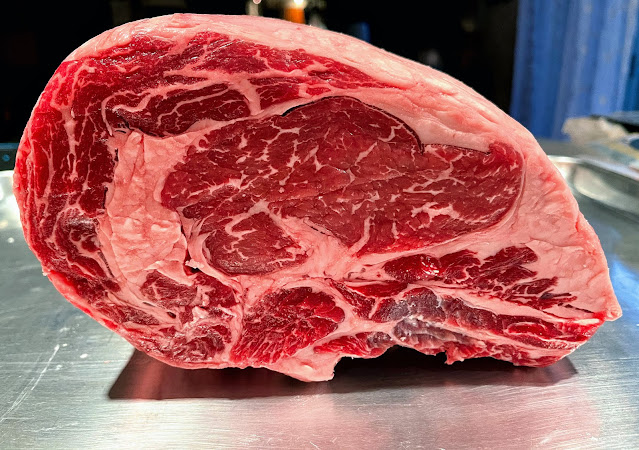


































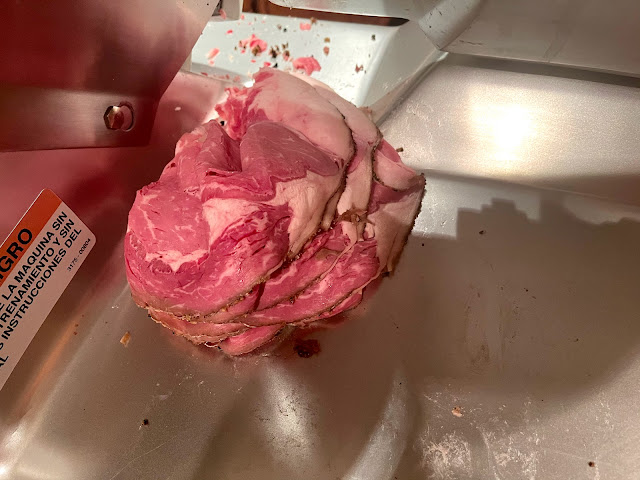







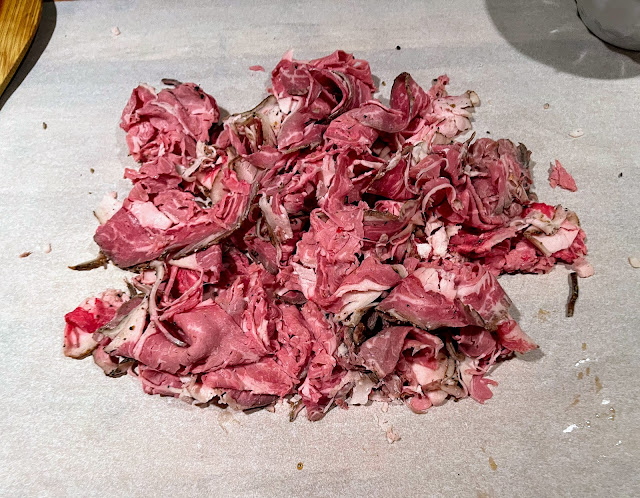

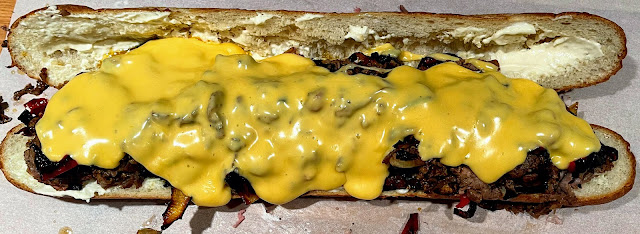

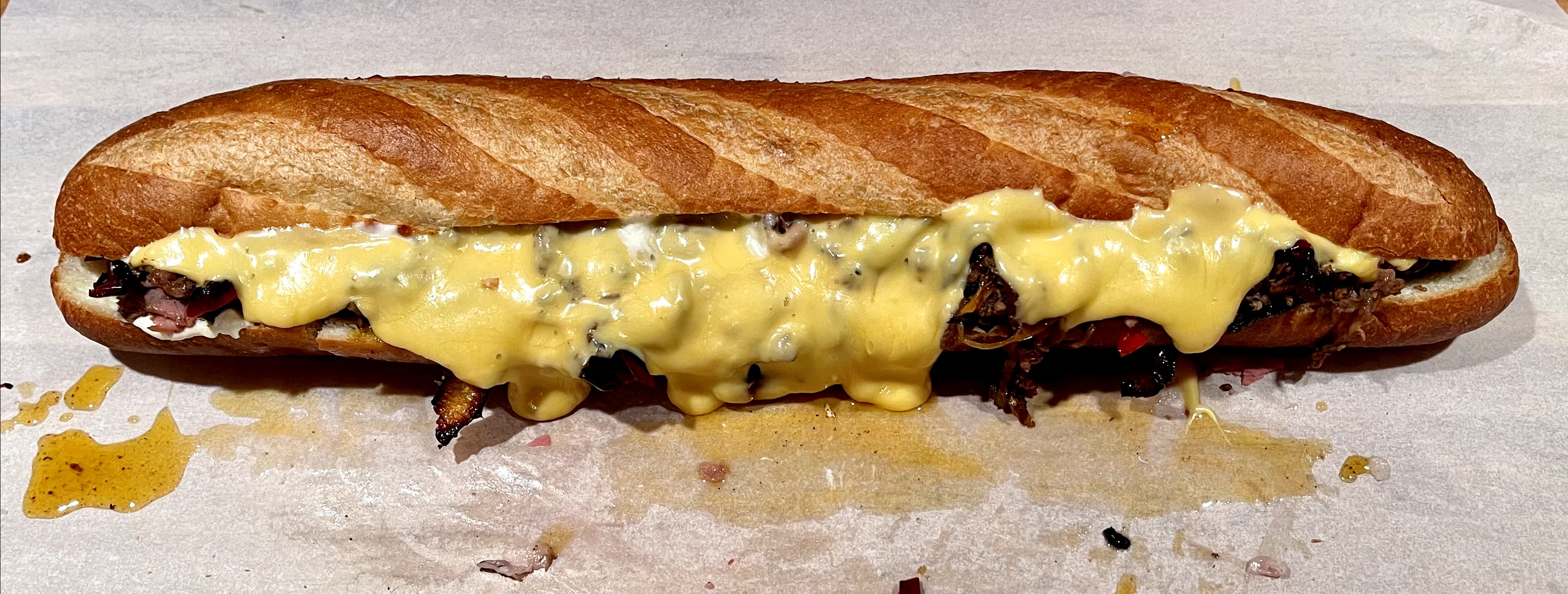


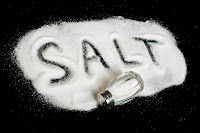

The Rib-Roast aka Prime Rib looks just so tender. I really love this kind of food so much. Thanks for sharing this.
ReplyDeleteSmoked New York Steak